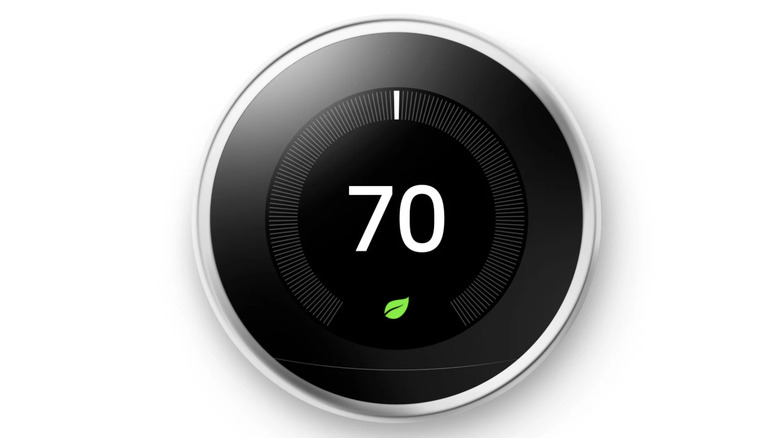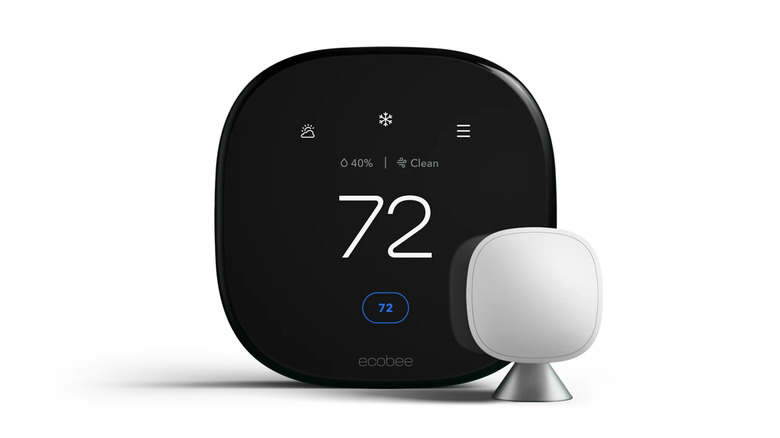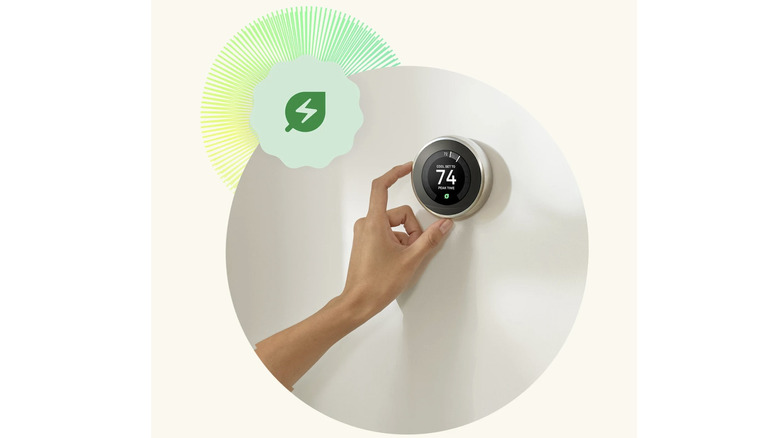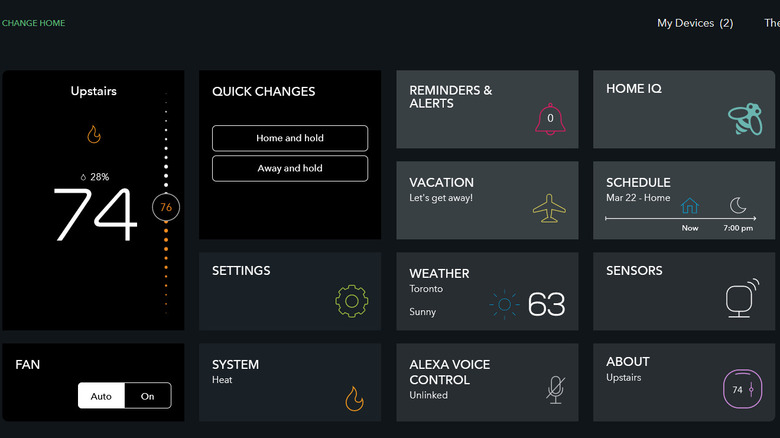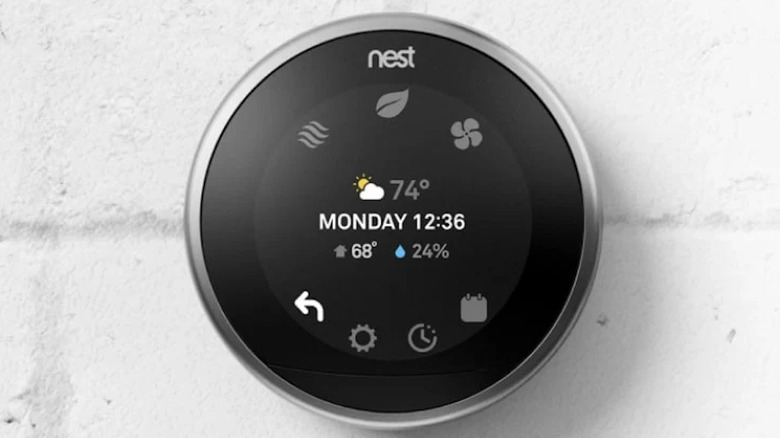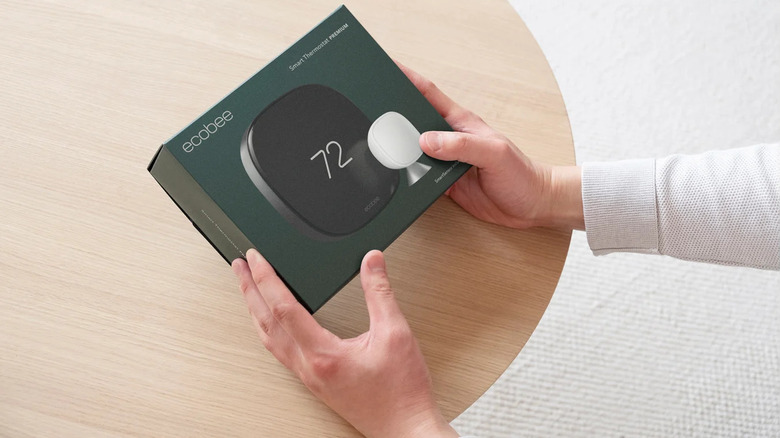Ecobee Vs. Nest: Which Is The Better Smart Thermostat & How Do They Compare?
We may receive a commission on purchases made from links.
The internet of things and its network of smart plugs and smart appliances have been rising in popularity for the better part of a decade. Many of us now use our phones, tablets, or voice to control our lights, music, and other parts of our home. Your thermostat is another logical part of your home that can be upgraded to work in this fashion, as it's usually a small device that you only need to occasionally adjust and control. That's exactly why smart thermostats are one of the more popular smart home products on the market. Not only do smart thermostats make it easier to control and monitor your home's climate control, but they can also save you money on your energy bill by offering a more efficient way to heat and cool your household.
If you're looking to upgrade your home's AC, heating or central air with a smart thermostat, you might find yourself overwhelmed by how many options are currently available. Two of the best smart thermostats you can buy are from Ecobee and Google Nest. While both are great choices, they each have their own pros and cons that need to be considered before deciding which brand is right for you. Here is a more detailed look at the smart thermostats made by Ecobee and Nest, based on information from their manufacturers as well as hands-on reviews from reputable sources. More information about how these products were evaluated can be found at the end of this comparison.
What is the Nest Learning Thermostat?
Nest was originally founded by former Apple engineers before being acquired by Google several years ago, and has since become Alphabet's premier line of smart home products. Google Nest has two different smart thermostats on offer: the Nest Thermostat and the Nest Learning Thermostat, with the latter costing more money, offering more features, and comprising different materials.
The former — the Nest Thermostat — uses a recycled plastic housing compared to the metal ring of the Nest Learning Thermostat. It's available in four different colors, all designed to be relatively unobtrusive and blend in with your home decor — sand, fog, snow, and charcoal. The Nest Learning Thermostat comes in polished steel, stainless steel, mirror black, black, white, brass, and copper. Other differences include how the two thermostats are controlled — the Nest Thermostat uses a swipe-and-tap method to adjust the temperature, while the Nest Learning Thermostat has a dial you can turn and press. The Nest Thermostat has a mirrored glass lens and the Nest Learning Thermostat has a high-res display with Farsight that will show you the time and weather in addition to the temperature.
A guided install and setup is available with the Nest Learning Thermostat through the Nest app, which can be used to control the thermostat in addition to the Google Home app. However, the Nest Thermostat only uses the Google Home app for installation, setup, and control, and isn't compatible with the Nest app. It also doesn't work with the Nest Temperature Sensor accessory. Furthermore, it's compatible with less heating and cooling systems than the Nest Learning Thermostat — 85% compared to 95%.
What is the Ecobee Smart Thermostat?
Ecobee is a Canadian company founded in 2007, specifically to address more efficient home heating and cooling. Currently, it has three different options available: the Ecobee3 Lite, the Smart Thermostat Enhanced, and the Smart Thermostat Premium. Ecobee says the latter two products can offer up to 26% savings on annual heating and cooling costs, while the more affordable Ecobee3 Lite can save you up to 23%. All three are Energy Star certified, and all three come with a Power Extender Kit that allows you to install the thermostat without a C wire. The two Smart Thermostats made by Ecobee use a built-in radar occupancy sensor to enhance their features and efficiency, which the Ecobee3 Lite lacks.
The Ecobee Smart Thermostat Premium has a die cast metal and zinc alloy frame with a black front four-inch full-color LCD touchscreen of 540 x 540 pixel resolution. The Ecobee Smart Thermostat Enhanced has the same exact touchscreen, though it's constructed of a black front with white backing. Don't assume the more affordable Ecobee3 Lite is an antiquated piece of tech compared to its big siblings, however. It may offer less features, but it looks nearly identical to the Ecobee Smart Thermostat Premium and has the same full-color touchscreen for easy control.
Which smart thermostat has more useful features?
In addition to the radar occupancy sensor that the Ecobee Smart Thermostat Enhanced offers, the Premium model also includes an indoor air quality monitor, and a SmartSensor. The SmartSensor detects which rooms have people in them, adjusting the temperature accordingly — plus when it notices that your home is completely empty, it can lower heating or cooling to save on energy bills. It also has humidity and temperature sensors. Furthermore, the Ecobee Smart Thermostat Premium is a smart speaker in disguise. It can be used for hands-free calling or as an intercom, and can play music either with Spotify or Bluetooth.
The device comes with a built-in security siren, as well as a voice assistant — you can choose to use either Siri or Alexa. Other features on both the Premium and Enhanced models include dual-band Wi-Fi, an on-screen security keypad, vacation scheduling, and A/C pausing when a window or door is left open. Using Ecobee's Eco+ system, these devices will use your routines, preferences, local weather, and grid activity to automatically adjust and improve your home's heating and cooling — it can even earn you up to $125 from your energy provider during peak demand times.
Similarly, the Nest Learning Thermostat can automatically create a heating or cooling schedule by learning your routine and preferences, plus offer savings suggestions, monitor your HVAC to catch any malfunctions or issues early, and turn itself down when you're not at home. The built-in sensors include temperature, humidity, proximity, occupancy, ambient light, and a magnetic one for the thermostat's ring position. The Nest Temperature Sensor — which is sold separately — can be placed pretty much anywhere, such as on a shelf or end table, to determine which rooms should be what temperature at particular times of day.
Which smart thermostat is easier to control?
Using its Farsight sensor, the Nest Learning Thermostat can light up when you walk in the room, allowing you to easily make any adjustments to the temperature it displays. The Nest Thermostats aren't smart speakers, but they are compatible with Alexa and Google Assistant devices. The Nest Learning Thermostat is Matter compatible and can use the Nest app, while the more basic Nest option does not have these features. Nevertheless, the Nest app is being phased out in favor of the Google Home app, which works in tandem with other Nest smart home products such as lights and security locks. The app offers core functions like setting the temperature, changing presets, and viewing your energy history. While Google is notorious for dropping support of its many different platforms, the company insists Nest products will have security updates for at least five years from when they were launched.
The Ecobee app offers similar functionality to the Google Home app and is available for iOS and Android. It also has an Apple Watch app that will allow you to control your home climate from your wrist. Furthermore, the Ecobee uses a handy slider for adjusting the temperature that you might appreciate. As with the Nest, Ecobee's thermostats work with IFTTT, Alexa, Samsung SmartThings, and Google Assistant, as well as Apple HomeKit — however, Ecobee does not support Matter, and hasn't said when it will start. While you can use Ecobee's smart thermostat without a subscription, you will need to pay $5 per month for its Haven subscription service to use all of its features that integrate with Ecobee's smart security system.
Which smart thermostat has better reviews?
The reviews of customers and experts who've tested and used these products give a helpful sense of which one is worth buying. PCMag gave the Ecobee Smart Thermostat Premium a solid 4.5 out of 5 and praised its "beautiful design" and air quality monitoring, among other features. On the other hand, CNET was a little more conservative with its praise, rating it a 7.9 out of 10. Its review found the app and features to be great assets, including the geofencing ability, however it considered the high cost a liability.
Wirecutter named both products when looking at the best smart thermostats of 2024, though it ranked Ecobee's Premium model slightly higher than the Nest Learning Thermostat, saying the former has "the best remote sensor" they tested, while the Nest was "easiest to set up using AI." Consumer Reports thoroughly tested the Nest and also found it was easy to install, though it reported that "it performs poorly in our automation test, which looks at how well the thermostat makes changes on its own." CNET rated the Nest Learning Thermostat higher than it did Ecobee's Premium option — an 8.5 out of 10 — praising its improved Farsight feature and more streamlined design from the previous generation.
While the consumers who've purchased these products may not have put them through the same rigorous testing as these publications, they will give you a good idea of customer satisfaction. Over 30,000 Amazon customers rated the Nest Learning Thermostat, resulting in a 4.4 out of 5 score overall. The Ecobee Smart Thermostat Premium scores slightly higher with a 4.5 out of 5, though this is averaged from a smaller base of around 2,600 customers.
Which smart thermostat should I buy?
While the expert reviews and customer ratings for the Ecobee Smart Thermostat Premium or the Nest Learning Thermostat are pretty close and you'll probably be happy with either option, Ecobee is the better smart thermostat when it comes to pure functionality. Not only does it offer more features, but it has a built-in smart speaker and — according to the stats claimed by both companies — offers significantly more heating and cooling efficiency for savings on your energy bill.
However, the Nest Learning Thermostat is still a high-quality product and there are multiple reasons you might opt for it over Ecobee's product. For one thing, you don't need a paid monthly subscription to unlock all of its features. For another, while Ecobee's device works with Google Assistant, the Nest Learning Thermostat will integrate much more easily into your overall smart home system if you use other Nest products or Matter-compatible devices, which are wider ranging and more popular than Ecobee's smart home options.
You can purchase the Ecobee Smart Thermostat Premium for $249.99 from Ecobee's website, as well as for the same cost or slightly less from retailers like Amazon ($249.99), Walmart ($229), and Home Depot ($249).
The Nest Learning Thermostat has the same list price as Ecobee's premium model, but is currently available for much less — Google is selling it for $169, which is also what it's priced at on Amazon. You can also purchase the product from Home Depot for $186.75 and from Walmart for $167.99.
The methodology used to compare these products
To accurately compare the smart thermostats made and sold by Ecobee and Google Nest, the manufacturer's product pages for each device were referenced. To corroborate the specs and listed features on these pages, as well as to ascertain whether or not these features and the devices themselves reliably work as advertised, reviews from people who have used the products were also consulted. These include expert reviews from reputable publications who cover tech devices and other smart home products — PCMag, CNET, The New York Times Wirecutter, and Consumer Reports.
Additionally, customer reviews of the products on Amazon were also referenced. Amazon was chosen as it's a massively popular retailer with a very large base of customer reviews providing an appropriate average user score for the smart thermostats. Using such a large base of customer reviews prevents any outlier ratings made in bad faith — whether positively or negatively — from having much of an impact on the overall score. To determine which of the smart thermostats is the better buy, the opinions of the majority of the reviews were a major factor, as well as overall and additional costs, energy efficiency, and the number of useful features included with each device.

